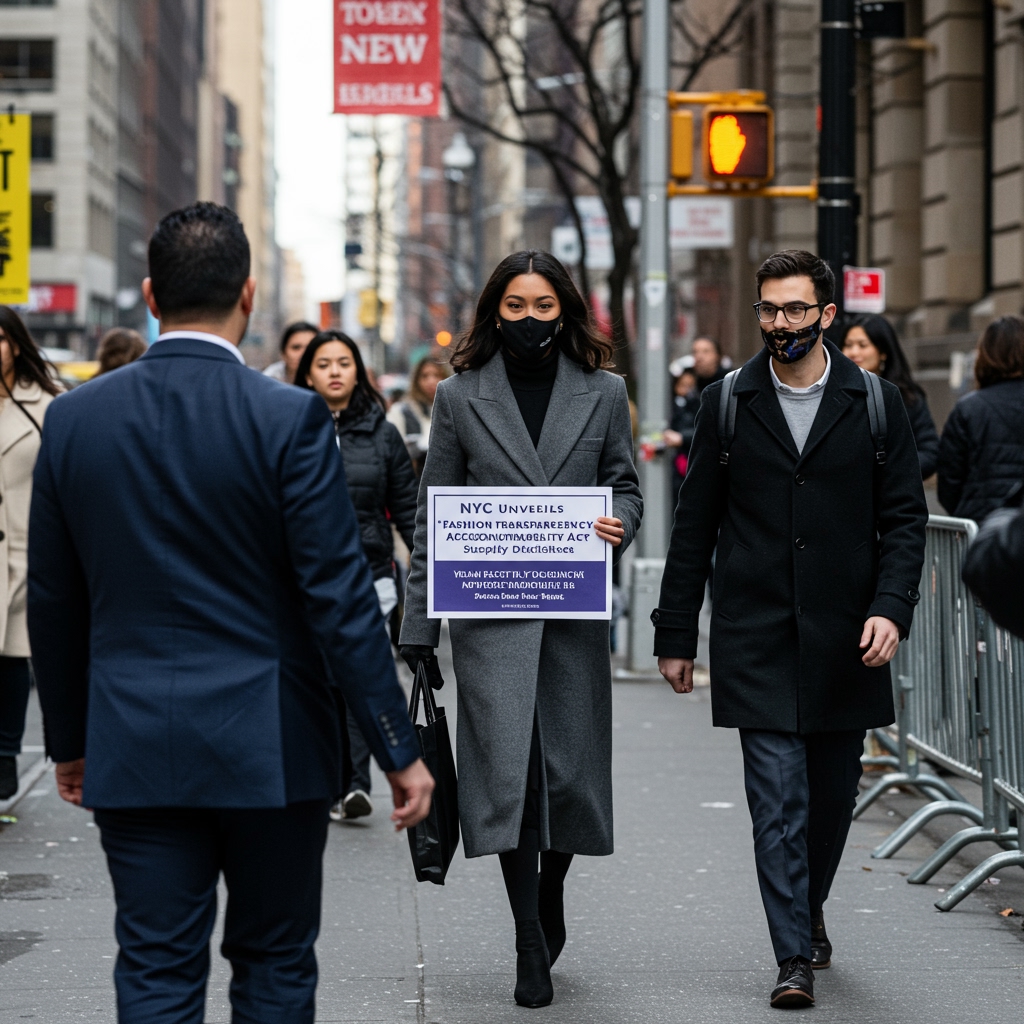NYC Eyes Landmark Fashion Sustainability Legislation
New York City is taking a significant step towards bolstering environmental and social responsibility within the global apparel and footwear industry. On March 22, 2025, the New York City Council officially introduced a pioneering piece of legislation, the “Fashion Transparency and Accountability Act”. This proposed law aims to fundamentally reshape how fashion companies operate within the city, mandating unprecedented levels of public disclosure regarding their supply chains, environmental footprints, and labor practices.
The bill is designed to address the often opaque nature of the fashion industry’s global supply chains, which can obscure environmental damage and human rights abuses. By requiring detailed public reporting, the Act seeks to empower consumers, investors, and regulators to make informed decisions and hold companies accountable for their impacts from raw material to finished product.
The “Fashion Transparency and Accountability Act”: Core Mandates
At its heart, the “Fashion Transparency and Accountability Act” imposes stringent new requirements on a specific segment of the fashion industry. Companies that meet the established criteria will be obligated to publicly disclose comprehensive data across three critical areas: supply chain mapping, environmental impacts across the entire lifecycle of their products, and detailed labor practice data. This tri-fold approach represents a holistic attempt to capture the full spectrum of a company’s operational footprint and its ethical implications.
The legislation is deliberately targeted to impact major players in the industry. The disclosure mandates apply specifically to apparel and footwear companies with global revenues exceeding $100 million USD that sell products within New York City. This threshold is intended to capture large corporations with substantial influence and capacity to implement the required tracking and reporting systems, ensuring the bill focuses on entities with the largest potential environmental and social impact.
Tracing the Thread: Supply Chain Mapping Requirements
One of the most challenging, yet crucial, requirements of the proposed Act is the mandate for companies to publicly disclose maps of their supply chains. This goes beyond simply listing key suppliers; the bill requires mapping down to the levels of raw material sourcing and manufacturing. This level of detail is intended to bring visibility to the earliest stages of production, which are often the most hidden and carry significant environmental and social risks, such as water pollution from fiber production or poor labor conditions in textile mills.
A publicly accessible supply chain map would allow stakeholders to understand the complex networks involved in creating a garment or shoe, enabling scrutiny of practices at various points along the chain. This transparency is seen as a key driver for improvement, as companies may be incentivized to address issues once they are brought into the public eye.
Environmental Footprint Disclosure: A Deeper Dive
The Act places a strong emphasis on understanding and disclosing the environmental impacts associated with apparel and footwear production. Companies are required to provide detailed reporting on specific environmental metrics, including greenhouse gas emissions, water usage, and chemical management. Importantly, this reporting must cover the environmental impacts experienced across the lifecycle of their products. This means assessing impacts not just during manufacturing, but also during the cultivation or extraction of raw materials, transportation, retail, consumer use (washing, drying), and end-of-life disposal.
Measuring and disclosing these impacts across the entire lifecycle provides a much more complete picture of a product’s environmental burden than focusing solely on manufacturing. It highlights areas where the greatest impacts occur, guiding companies towards more sustainable materials, production processes, and product design. The focus on chemical management is particularly relevant given the widespread use of chemicals in dyeing, finishing, and material production, many of which can pose significant risks to workers and the environment.
Fair Labor Practices: Ensuring Accountability
Beyond environmental concerns, the “Fashion Transparency and Accountability Act” also tackles crucial social issues within the industry, particularly concerning labor rights. The bill mandates public disclosure of labor practice data, including information on fair wage initiatives. Like the supply chain mapping and environmental reporting, this labor data must be traced down to the levels of raw material sourcing and manufacturing.
This requirement aims to shed light on working conditions in factories and farms where fibers are grown or materials are produced. Companies will need to report on efforts to ensure workers are paid fair wages, defined in relation to local living costs, and other critical labor standards. Transparency on labor practices is intended to combat issues such as forced labor, child labor, unsafe working conditions, and the suppression of workers’ rights, which are unfortunately prevalent in parts of the global fashion supply chain.
Scope of the Proposed Law: Who is Affected?
The criteria for determining which companies fall under the purview of the “Fashion Transparency and Accountability Act” are clear: global revenues exceeding $100 million USD and selling products in New York City. This means the legislation targets large, multinational fashion corporations rather than small independent designers or retailers. The rationale is that these larger companies possess the resources and scale to implement the complex tracking and reporting systems required by the bill.
New York City’s status as a global fashion capital and a major market provides the basis for the city’s jurisdiction over these companies. By setting a precedent in a key market like NYC, the bill could potentially influence practices across the industry globally, as major brands may standardize their reporting to comply with the strictest requirements they face.
Enforcement and Penalties: Teeth for the Bill
To ensure compliance, the proposed Act includes significant penalties for companies that fail to meet the disclosure requirements. Non-compliance could result in fines up to 2% of global revenue or $5 million USD, whichever is higher. This tiered penalty structure, based on global revenue, ensures that fines are substantial enough to serve as a deterrent for even the largest corporations. The “whichever is higher” clause prevents a low fixed maximum from being insignificant for multi-billion dollar companies.
The bill reportedly includes an initial grace period to allow companies time to establish the necessary systems and gather the required data before penalties are enforced. However, once this period expires, the potential financial consequences for non-compliance are severe, underscoring the city council’s commitment to the bill’s objectives.
The Path Forward: Legislative Review and Vote
As of its introduction on March 22, 2025, the “Fashion Transparency and Accountability Act” is currently under review by the New York City Council’s Environmental Protection Committee. This committee is responsible for examining the bill’s provisions, holding potential hearings, and considering amendments. The review process involves evaluating the feasibility of the requirements, potential impacts on the industry, and alignment with existing regulations.
A potential vote by the full City Council is currently expected in late April 2025. The outcome of the committee review and subsequent council vote will determine whether this landmark piece of legislation becomes law, potentially setting a new standard for accountability and sustainability in the fashion industry operating within New York City and beyond.
Significance and Potential Impact
The introduction of the “Fashion Transparency and Accountability Act” is a significant moment, potentially positioning New York City at the forefront of legislative efforts to address the fashion industry’s environmental and social footprint. If passed, the bill could serve as a model for other cities or jurisdictions seeking to impose similar transparency requirements. For the affected companies, it would necessitate substantial investment in traceability systems and data collection infrastructure. While potentially challenging for businesses to implement, proponents argue that increased transparency is essential for driving meaningful progress towards a more sustainable and ethical fashion future, benefiting both the planet and the people who make our clothes and shoes.





